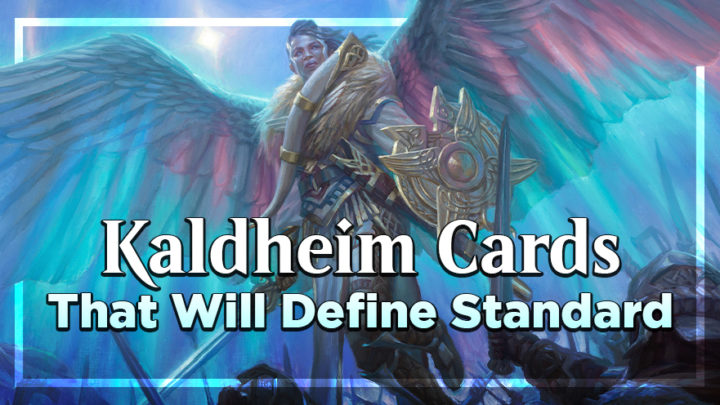We are one week out from Kaldheim releasing on Arena, which will give us a brand new Standard format to explore (and potentially break). This current Standard format has been a fun and exciting one to play, but that’s all in the past now. Today, we’ll be looking toward the future, as we go over five cards from Kaldheim that will be big players in Standard.
Sigrid, God-Favored
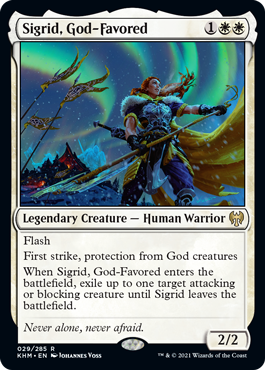
Sigrid reminds me of Hixus, Prison Warden, but ten times better. While she’s only a 2/2, she’s also significantly cheaper and has first strike, allowing her to eat a lot of creatures in the developing phase of the game. She’s one of those rare cards that both white control and aggressive decks want to be playing. She excels at punishing decks that curve out, but can also be used as a way to remove a problematic blocker for your aggressive deck.
The only real downside to Sigrid is how poorly she lines up with Bonecrusher Giant — a format-defining creature in current Standard. But depending on the deck you’re playing, that might not be a huge worry. If you’re playing an aggressive deck, you’ll have plenty of ways to up Sigrid’s toughness out of Stomp range. For control and midrange decks (where I expect this card to be at its best), having one combat step where you remove one creature and eat another is plenty of value.
The biggest appeal of Sigrid, as I see it, is how she threatens to punish Gruul players who want to curve into a turn-four Embercleave. Let’s say you’re playing Gruul and your opponent has three mana up, two of which is white. If you cast an Embercleave, are you going to put it on the biggest creature to push damage? Or are you going to buff up your 1/1 so that it will trade with Sigrid and you can get your bigger creature back? What if they don’t have Sigrid — can you afford to do that much less damage? This sort of play pattern is why I am so high on Sigrid. And that’s before we even think about how well she lines up against decks like Rogues and Food.
Along with all of that, Sigrid has protection from Gods. While this seems mostly flavorful, there are a few Gods that could see play in Standard; if that turns out to be the case, then you get this random hate card at virtually no opportunity cost. If that’s not value, I don’t know what is!
Resplendent Marshal
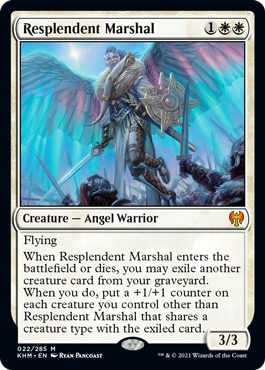
When I mentioned ways to increase Sigrid’s toughness, this is exactly what I meant. This card reminds me of Unbreakable Formation, but you also get a creature out of it. A 3/3 flying creature at that!
Resplendent Marshal opens the door for various tribal decks out, and only time will tell how many Marshal will aid in battle. One good option to start with is Warriors: a creature type that has received a fair amount of support in the last year. Cards like Rally the Ranks, Usher of the Fallen, and Seasoned Hallowblade work well with this card and could easily make the list on their own merit.
For Marshal to get its full value, you need a creature to die before playing it. Fortunately, if your opponents aren’t answering your pressure early, you’re probably running them over, anyway. You’ll also still get a trigger when Marshal dies, which is important to keep in mind. Marshal is large and evasive enough that your opponents won’t want you keeping it around, but if they do manage to remove it, you could end up spreading its power across multiple creatures. Marshal really demands a board wipe as an answer, which is a fantastic quality in an aggressive card.
Arni Brokenbrow
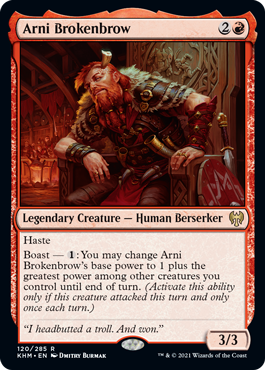
Mono-Red hasn’t gotten a lot of love in recent Standard. Its one-drops are fairly medium, as are its three-drops. But with the release of Kaldheim, Arni Brokenbow might just give Mono-Red a shot in the arm.
Arni has obvious synergy with Anax, Hardened in the Forge. If you play Anax on turn three, play Arni on four, and swing out, you’re putting massive pressure on your opponent. Arni also works well with Rimrock Knight, which can increase Arni’s power with Boulder Rush or by serving as a target for Arni’s boast ability. These are the sorts of synergies that red decks have been lacking for some time.
Arni could also help enable entirely new archetypes. Berserkers seem to be a supported tribe in this set, and the Red-Black Knights decks from last year could provide some additional pieces. There have been fewer incentives to play aggressive decks in the interim, but maybe Kaldheim has enough to make them viable again.
One thing to keep in mind with Arni is that a 3/3 with haste is a fine rate for this card as just another curve out pressure play. Too often, players look for the best possible play with a card when evaluating it, but the floor on this card is fine. The three toughness makes it immune to Stomp, which is a defining trait of playable aggressive cards in this format. While Arni is not an automatic four-of, it’s a card that can easily fill two or three spots in your aggressive red decks so you can start applying ample pressure to your opponents.
Doomskar
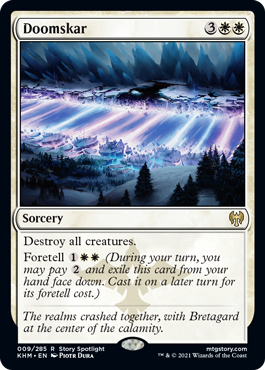
Aggressive decks are getting plenty of new creatures in Kaldheim, but control decks are getting some valuable cards, too. Doomskar is being heralded as the best Wrath effect since Supreme Verdict! While I’m not necessarily in that camp, I do think Doomskar will see lots of play and it will have a profound effect on the format.
Simply put, if you’re playing an aggressive deck in Standard, you will have to respect that your opponent could have Doomskar as early as turn three. In current Standard, if you’re on the play, you can often run over a control player before they get four mana to cast Extinction Event. Doomskar threatens to put an end to that.
Another point in Doomskar’s favor is the ability to cast it for three mana on turn five, while still having mana left up to answer a follow-up play. Often, the play pattern to punish control decks is to hold a game-swinging card for the post-Wrath turn on curve and put them on the back foot for the rest of the game. Doomskar allows control decks to circumvent that play pattern. Changing the rules of engagement like this is critical for control decks to flourish, as they plan to win by answering all the things the opponent is doing.
While there is some small added benefit to “bluffing” which card you foretold, many players will be able to sniff out which cards you have face-down. In some cases, it will be more of a detriment than a blessing. If you’re playing against a savvy player and you foretell your Doomskar, your opponent will start piecing together which cards you may have foretold and make plays accordingly. But if you simply hold your mana up and avoid foretelling cards, your opponent may not suspect that you have a Doomskar. After all, why wouldn’t you want to spend less on it if you had the chance? Many Magic players (myself included) love when we get to be fancy or tricky, but sometimes the cleverest thing you can do is to make the obvious play.
Jorn, God of Winter
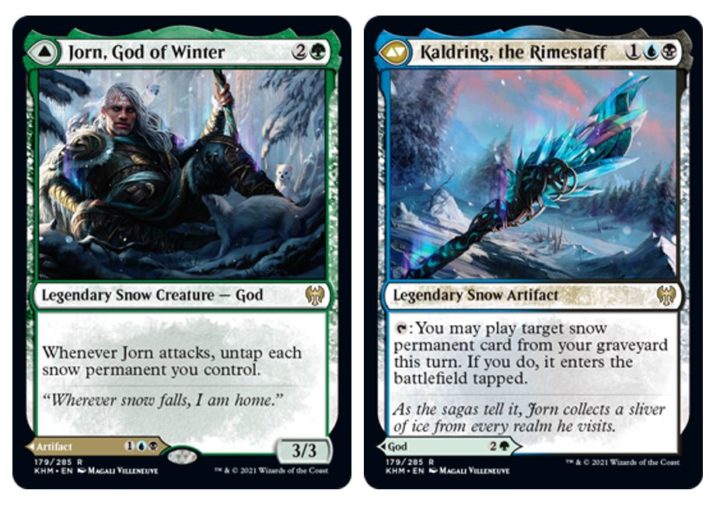
“You know nothing of doubling mana, Jorn Snow.”
Jorn has a lot of buzz coming out of preview season. With memories of Wilderness Reclamation fresh in our minds, Jorn has sent shivers down many players’ spines. While he may not be as absurd as Reclamation, Jorn is looking to make some big waves himself. (And that’s before we even look at the back half of the card, which will allow you to have access to infinite Jorns, at worst.)
Jorn seems like he’ll do best in a mono-green deck. This will allow you to play 15-17 Snow-Covered Forests to maximize the value you get from untapping with Jorn. While some cards like Castle Garenbrig might still be worth the inclusion, we want to focus on maximizing Jorn’s ability. That’s not to say you can’t play a multicolor deck to get the best use of Kaldring, but a mono-green deck can still find ways to make blue and black to cast the back half (any lovers of Gilded Goose in here?)
Since Jorn doesn’t need to connect to untap your snow permanents, you can do a few things to help protect him that should work with your main game plan. Garruk, Unleashed can make Jorn big and give us a play to make on turn four. Cards like Wicked Wolf, Ram Through, Primal Might, and Inscription of Abundance will also help Jorn survive another turn cycle and give us something to do with the extra mana Jorn provides.
There are plenty of other payoffs for Jorn, even if he ends up dying in combat, and Vivien, Monsters’ Advocate, is a great one. Since Vivien costs five mana, you’ll often need a turn cycle before you can start playing creatures off her static ability. Now, we can trade Jorn for the mana to play more creatures off the top of the library and potentially even grab another Jorn off Vivien’s -2.
These are just a couple of things Jorn can do in mono-green alone. As time goes on and players figure out the optimal cards to surround Jorn with, the ceiling on this card could be incredibly high.
And these are just a few cards from the set that are looking to make an impact on Standard! The most exciting part about this time of year is that we don’t know which cards will make the biggest impact until we start playing with them. I’ll have some new Standard decklists for you next week — and if you’re looking for the best Kaldheim cards to craft for Historic, be sure to check back here for Ally Warfield’s article tomorrow.
What card are you most excited for in Kaldheim? Tweet at @masoneclark and @card_kingdom and let us know!

Mason Clark is a grinder in every corner of the game who has played at the pro level and on the SCG Tour with Team Nova. Whether he’s competing in Standard, Historic or Modern, Mason plays with one goal in mind: to be a better player than he was the day before. Check out his podcast, Constructed Criticism, and catch his streams on Twitch.

